-
Posts
2,941 -
Joined
-
Last visited
Content Type
Profiles
Forums
Gallery
Events
Posts posted by Hubac's Historian
-
-
1 hour ago, Bill97 said:
Ok Marc I think I got it. I am also turning my own yards instead of using the Heller plastic yards. In the photo I show the foreyard and the topmast yard all ready turned for the foremast. I made them to match the size of the Heller yards. The topmast yard is 7 3/4”. So according to what you have said the topgallant yard should be .451 of 7 3/4” or roughly
3 3/8”?
Further my fore course yard is 12.125”. So if I go by what you said above my fore topmast yard should be .672 of 12.125” or roughly 8 1/4”? The one I made is too short at 7 3/4”. So if I remake it at 8 1/4” my topgallant yard will be about 3 3/4”?
Bill, I’m a little confused - are you only referring to the yards you have made for the foremast, or does your second paragraph mean to reference the main course yard (12.125”), and its accompanying topmast and t’gallant yards?
-
-
What I’m saying is that the SP monograph spar dimensions probably don’t match any of the Heller spar dimensions. I’m making all of my yards from scratch, so I will just use these proportional ratios from the main and fore course, on up.
However, Hellers spar dimensions may be significantly larger overall. If you are only making those t’gallant yards from scratch, then mock them up with those ratios, relative to the kit topmast yards. See if they look too small.
-
The problem with applying this to the Heller kit is that the depth in hold, at the main mast position is too shallow, so the main mast as-moulded is not to scale.
My personal inclination - using the SP monograph as my guide - would be to make the t’gallant yards proportional to the topmast yards. For the mainmast, the t’gallant is .455 of the topmast yard.
For the foremast, the ratio is negligibly different at .451 of the topmast.
Relative to the monograph, I suppose I should also mention that the fore topsail yard is .672 of the fore course yard. At the main, the ratio of topsail to main course yard is also .672.
The relative proportions of Hellers main and topmast yards are likely different from those of the SP.
-
Good catch on the counter discrepancies, there.
Yeah, I have often thought La Royal Therese would be a wonderful subject for a model because we have such good VdV drawings of her bow and stern.
- Bill Morrison, kirill4 and John Ott
-
 3
3
-
In New York City, we are accustomed to stretching the few square feet available to us into the functional equivalent of an art gallery loft.
No, it is not sufficient, but it will have to do for now. I would say that, at least it is my own designated space, but my kids are already threatening to do their homework there.
-
John, there are some real gems in that folder. Thank you for sharing. I am particularly fascinated by Le Furieux. Like the Terrible of 1693, she has a number of grotesques decorating the quarters, and the structure of the upper quarters is very unusual.
- kirill4 and Bill Morrison
-
 2
2
-
4 hours ago, John Ott said:
John, you’re living your best modelers’ life over there! What I would give for that expanse 😀
-
-
You never disappoint with sources, Kirill. I will be taking a look at Ab’s rigging schematics. Your point about Marquardt is well-taken; his illustrations are particularly helpful, but picking out those elements that apply to my time period is a little tricky.
The filling seems to have been an element of French practice. Below, it is a little obscured by the gunport lids, but you can see that this area has been filled flush with the wales because the preventer plates span that gap and the rings need to be flush with that outer surface:
- rybakov, FriedClams, popeye2sea and 10 others
-
 13
13
-
John, do you have the complete illustrations for the upper and bottom of these three quarter drawings?
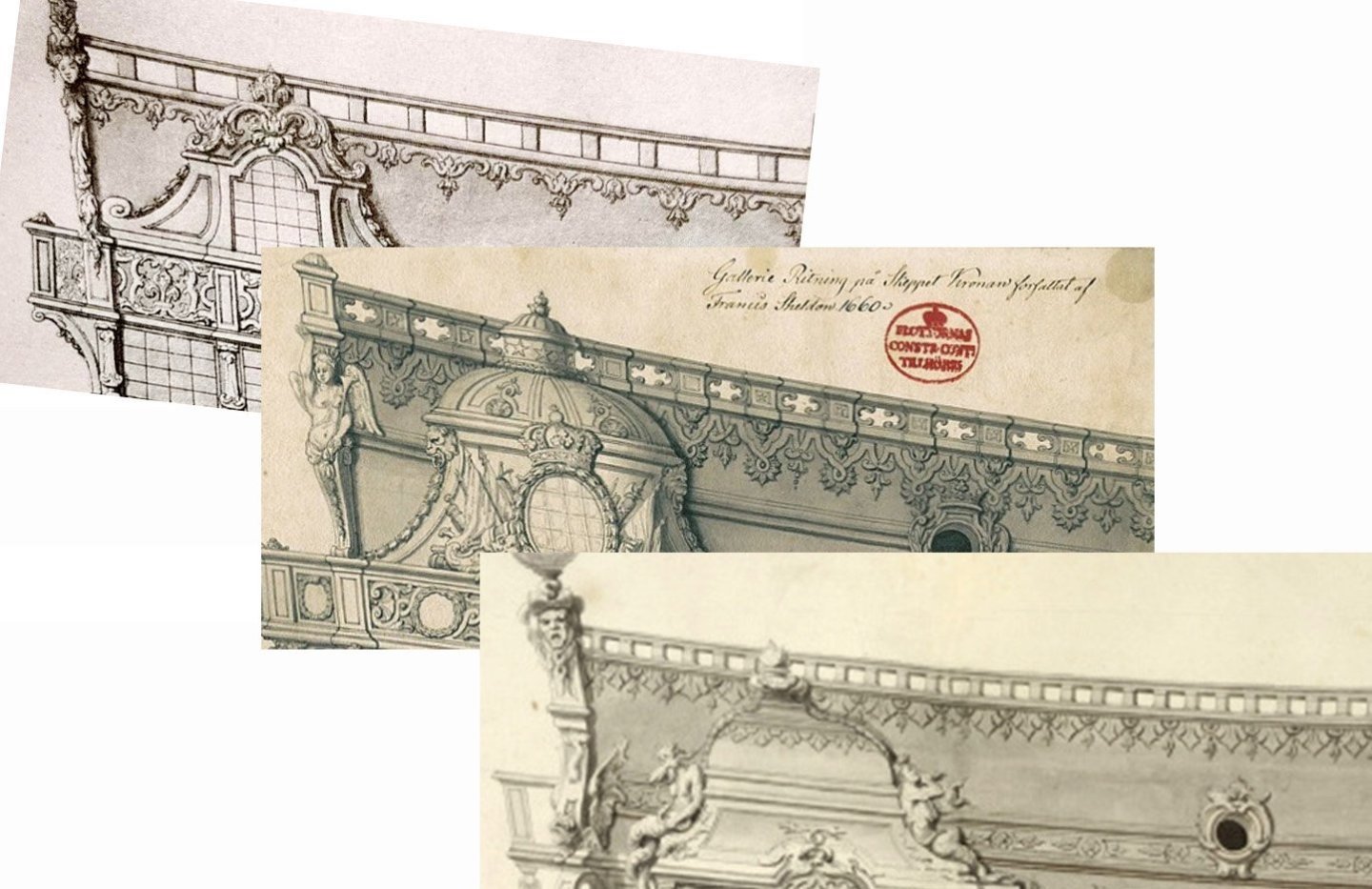
Do you also happen to have the bow and stern views. I’ve never seen these two before.
-
I’ve been off the forum, but not completely inactive. My new work table has arrived and I love it! Solid Birch. Gateleg. Six drawers of storage.
I have also taken exclusive proprietorship over my repro Lancaster County Fanback - a chair that I, alone, love.
Arrayed along the back are all of the rigging specific books I have acquired and borrowed. Among the latter are Marquardt’s tome on 18th Century rigging, as well as a reader-friendly binder expansion of Anderson’s Rigging in the Days of the Spritsail Topmast, both of which were lent to me by Dan Pariser - thanks, again, Dan!
I like to use Anderson as my baseline, particularly the earlier edition, because he calls out Continental and particularly French differences. Simultaneously, I keep pace through Lees, Marquardt and the binder version of Anderson, which is actually the later edition that focusses specifically on English practice. Simultaneous to all of that, I am referencing my photo library of models to reference fair leads and really see what all of this is supposed to look like.
One model that has been particularly helpful as a reference is the following of L’Ambiteaux, in 1:96. The photography expands in high definition and you can really see where it all leads to. The full-site version has many more pictures than the mobile version:
https://www.modelships.de/Ambitieux/Photos_Ambitieux.htm
Because my knowledge of rigging is so limited, this has always felt to me like the most daunting aspect of the build. Gradually, though, as I follow Anderson’s advice and read through the entire book before starting, I am developing a vocabulary and understanding of what all of the lines do. Slowly, I am beginning to see how to map out my belay points.
Of course, I have been the benefactor of A LOT of extra help, here, with John Ott being completely open about his sources and his own belay plan and line-scale corollaries. Michael D (72Nova) has been exceedingly gracious in sharing his rigging techniques in very small scale. And Kirill has also been exceedingly generous in sharing photographic resources and his own knowledge. Thank you to all and many others! I think, as I get into it, I will come to enjoy the rigging process. I am, nonetheless, determined to make a passably good job of it.
In the meantime, before I could strop deadeyes and fabricate chains and preventer plates, I needed to fill-in between the middle deck wales at the fore and main channel locations:
Work continues slowly on the Africa figure. I am in the process of defining shapes and volumes. All of my edge tools were pretty dull, though, so I took a little time to brighten their edges.
Little by little, we are getting there. Thanks for looking in!
Best,
Marc
- popeye2sea, Jeff T, shipman and 17 others
-
 20
20
-
-
-
I don’t think one can go too far wrong with pinrails from about 1690, forward, on French ships.
-
That is dissertation- level historical writing, John. You manage to resurrect these long-dead individuals as men of a particular background with their own motivations. It all makes for excellent reading, while also contextualizing the magnitude of SR2 and her importance to the fleet.
I have long wondered what your particular process was for decorating the upper works. Now that I understand it - my hat’s off to you for engineering such a brilliant execution of these details. The resin-casting of ornaments really was a laborious undertaking, but I have never personally regretted the effort, and I am guessing that you feel much the same. You could have passed with just the decal representations of the frieze ornaments, but casting them in 3D brings the whole thing to life.
I am living my best SR Renaissance with so many excellent models of her, in progress!
- Bill Morrison, Theodosius and John Ott
-
 3
3
-
Super brilliant stuff, as always, Daniel!
- JohnLea, dafi, Old Collingwood and 2 others
-
 5
5
-
It seems logical to me that the lower gallery tier would be one continuously open space; at the aft end, there will be the functional seat of ease, while on the forward end, there would be a removable false window panel concealing the gallery gunport. I also think it likely that, within the gallery, the port would be equipped with a water-tight port lid. In the event that the gallery is heavily damaged, or washed away in a rough seaway, there would still be a barrier for keeping sea water out of the hull. The entry doorway to the gallery would have a door, for the same preventative purpose, so the gun port would have a port lid.
So, the question then becomes a matter of display; do you want to show that there is a gunport hidden behind a false window panel, or do you want to present the un-interrupted facade of the gallery, and presume that the viewer understands there would be concealed gun ports within the gallery?
It seems unlikely to me that the French would disrupt the continuity of their design with a missing panel in the gallery.
I suspect that this modeler was indicating in a stylized way that there is an active cannon port behind this middle false window panel:
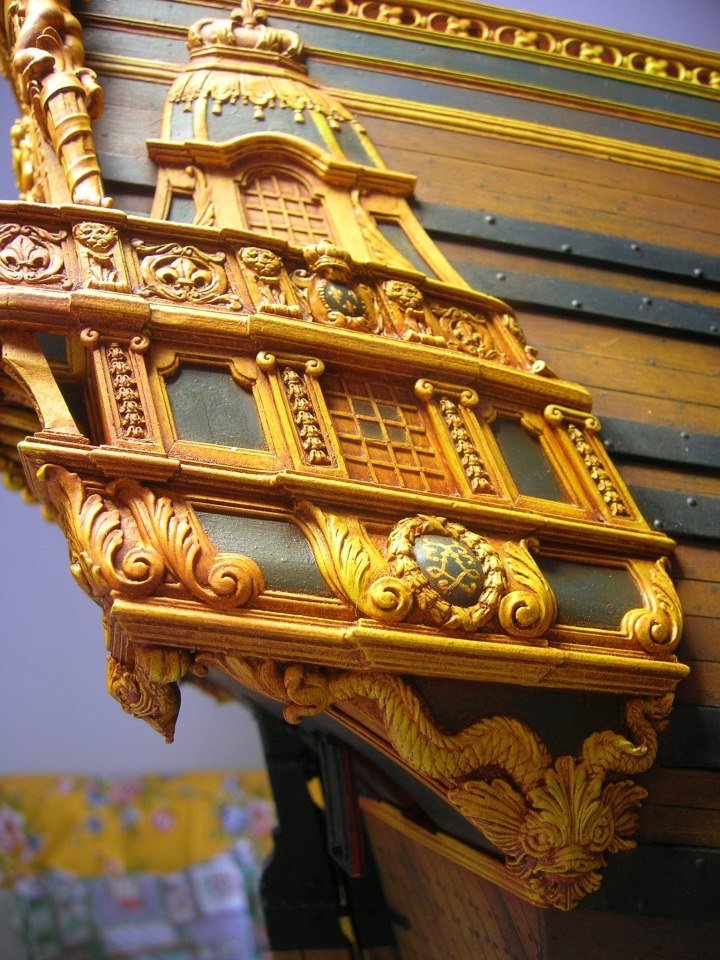
Although, it would make more sense for that port to be placed in the panel space to the right, as you are indicating with Le Fulminant.
-
Nice cliff-hanger on the Velez Malaga tale of intrigue!
I like your margin plank solution to the deck problem. I have also, lately, become interested in certain instances where modelers eschew priming; in this instance, the color of the moulded plastic is actually an ally to the desired effect. The decks really do look brilliant.
I’m looking forward to the next installment in this serial build log - clog, leak and spit away!
- John Ott, Bill97 and Bill Morrison
-
 3
3
-
-
Very delicate relief carving - nicely done!
- FriedClams, Siggi52, druxey and 1 other
-
 4
4
-
-
4 hours ago, HAIIAPHNK said:
Thank you so much for your opinions. I really appreciate your participation.
I just don't understand everything. Is it possible to repeat a little differently what this is about? The translator is telling me about the order in Wales or some rollers and I don't understand what is actually written.And in the meantime, I'm going to ask this. I don't know how to properly translate the Russian terms of the whole hinged structure we're talking about now. In Russian it sounds like "shtultsy". Sometimes they say "shell" or "side gallery".
And how will this structure sound in English? If I remember correctly, I think it should be called "Quarter gallery". But I'm not sure if it's the whole structure or just the lower part? What is the correct name?In English, the wales are the double bands of thicker timber that follow the upward sheer of the ship, often crossing over the aft-most ports. The French call these timbers the precients.
The “quarter galleries” encompass the entirety of the lightly framed side structures, which include the functional seats of ease - usually on the middle deck level, as well as the upper and lower finishing.
The French call these structures, bouteille for their resemblance to perfume bottles.
-



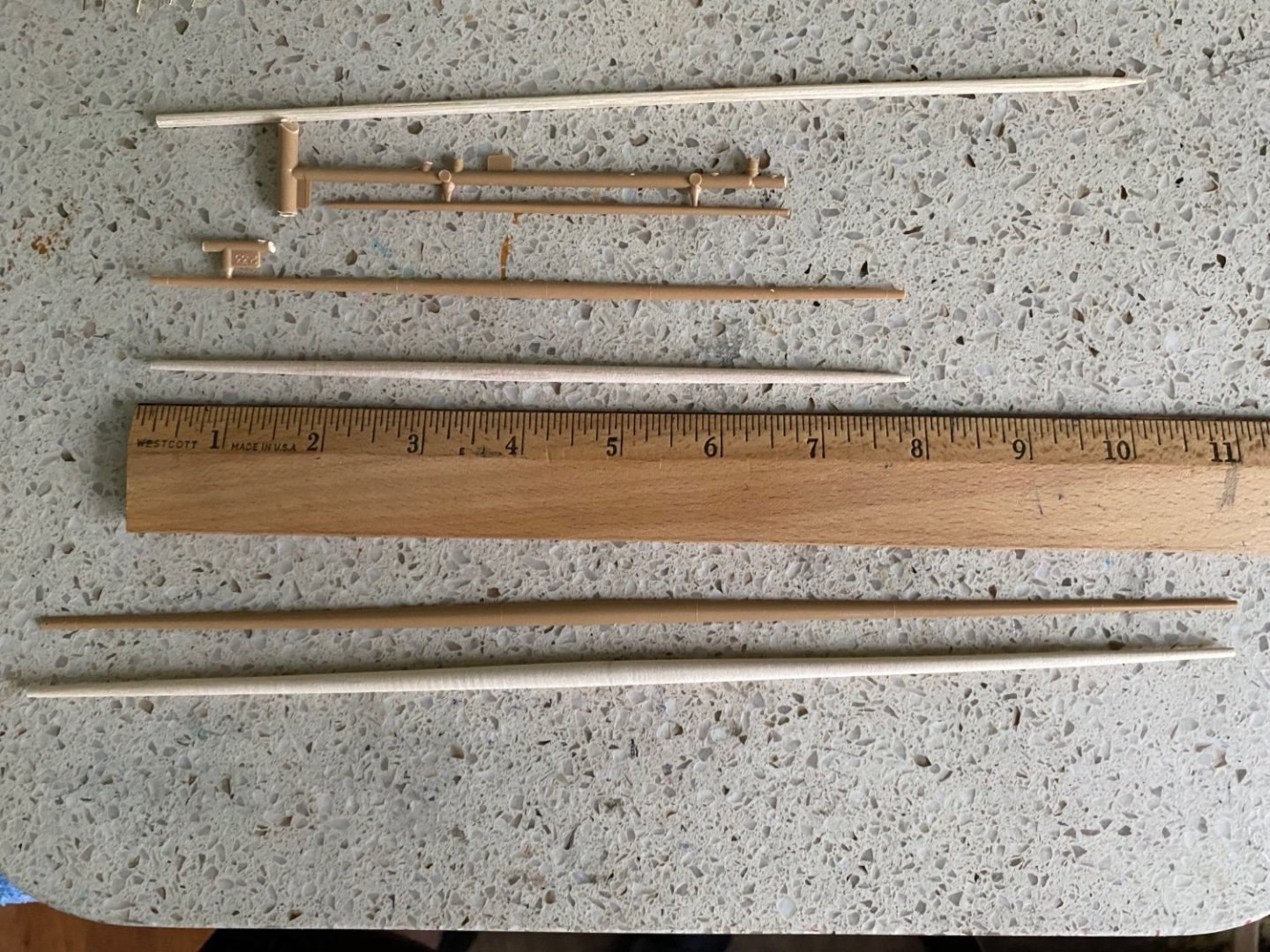


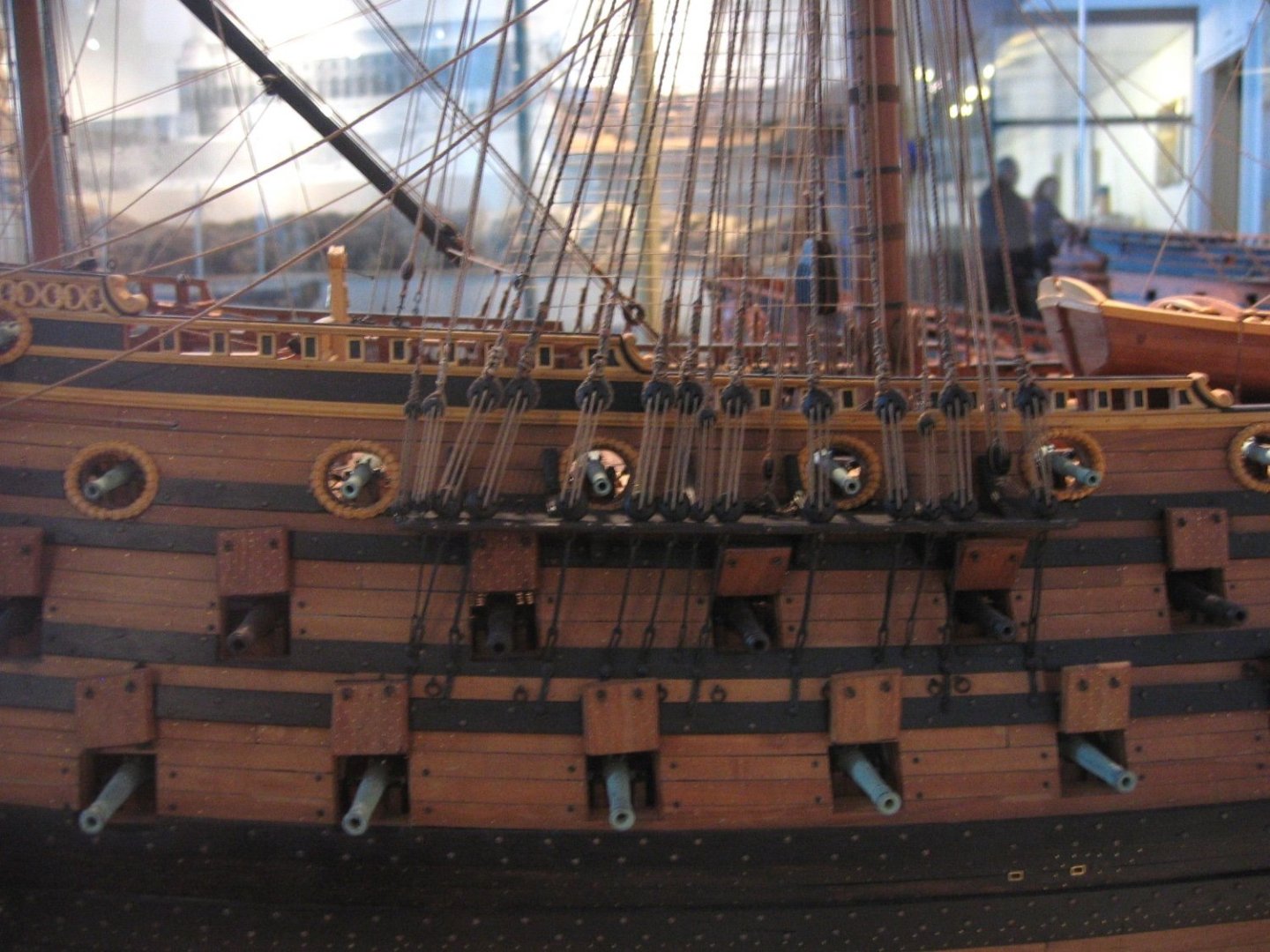
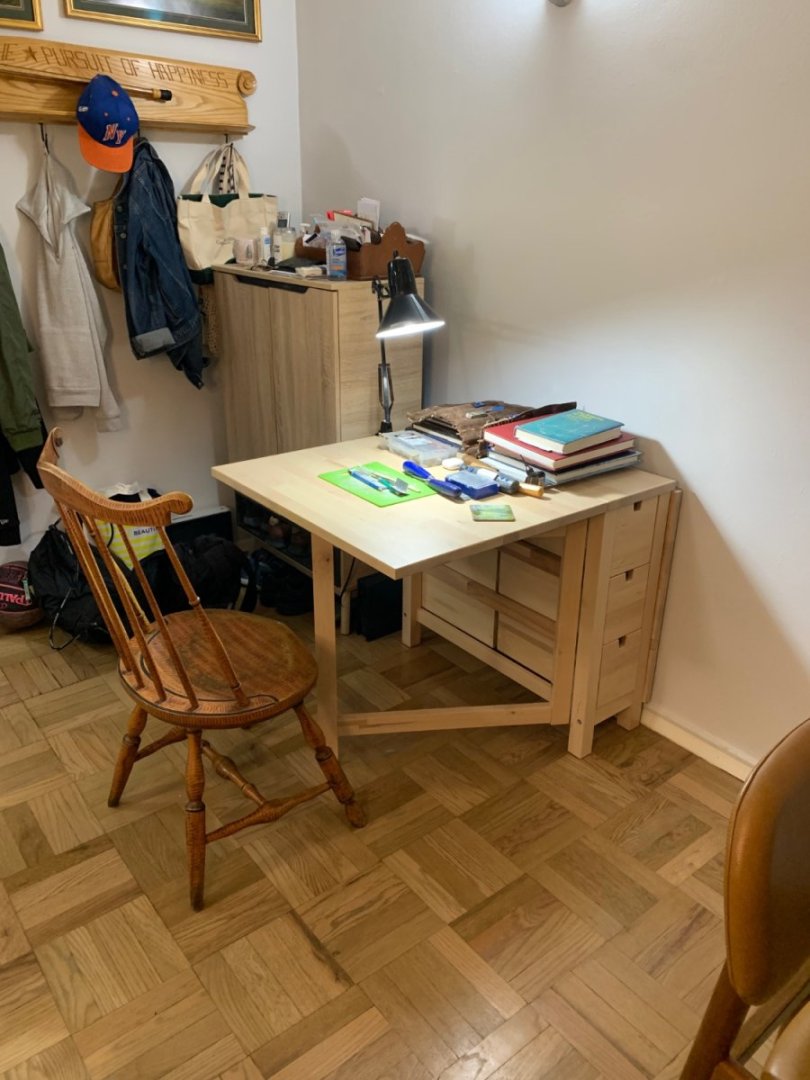
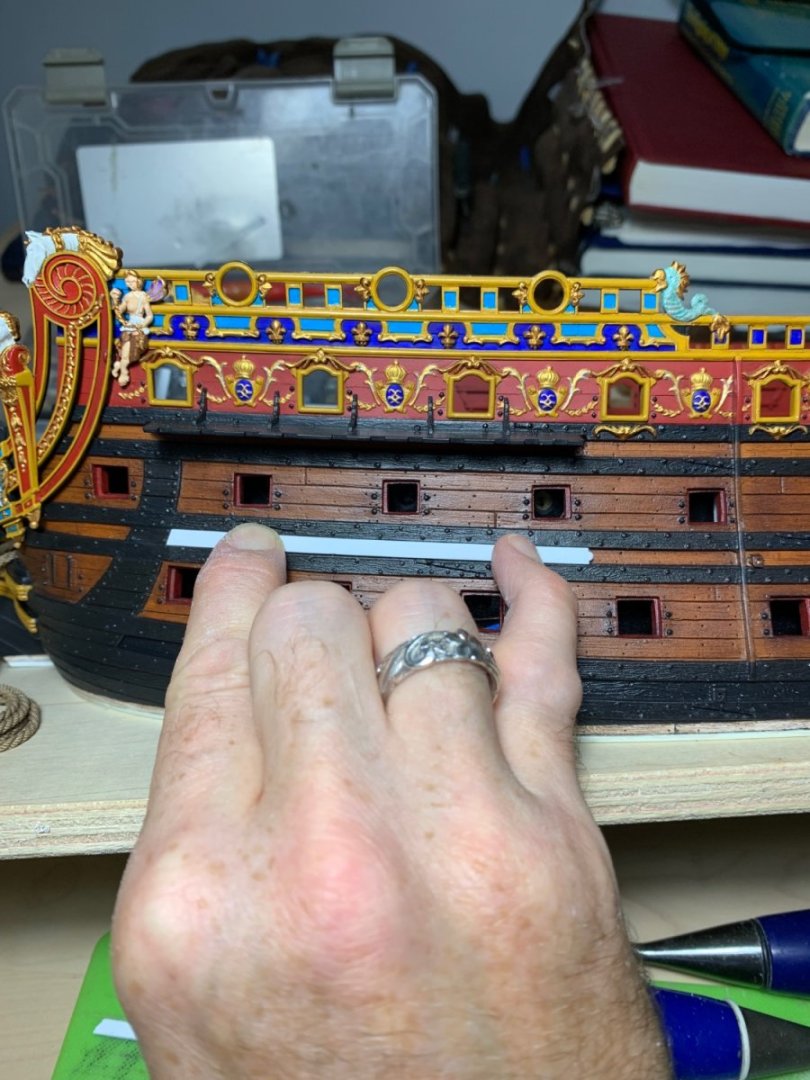
Le Soleil Royal by Bill97 - FINISHED - Heller - 1/100
in - Kit build logs for subjects built from 1501 - 1750
Posted
I understand now, thank you. So, out of curiosity, how do those revised topmast and t’gallant yard lengths compare with the stock yard dimensions?